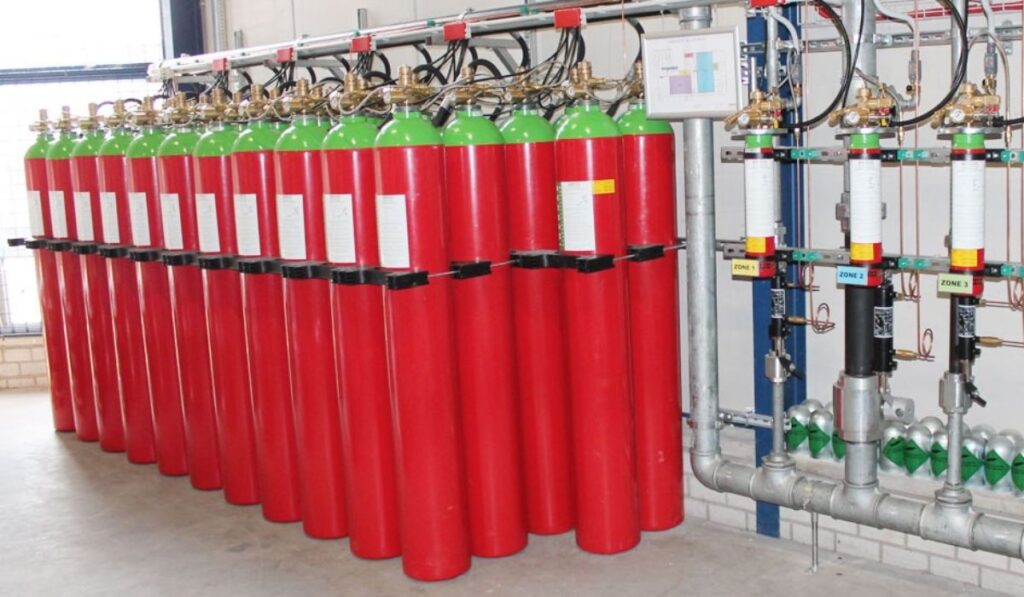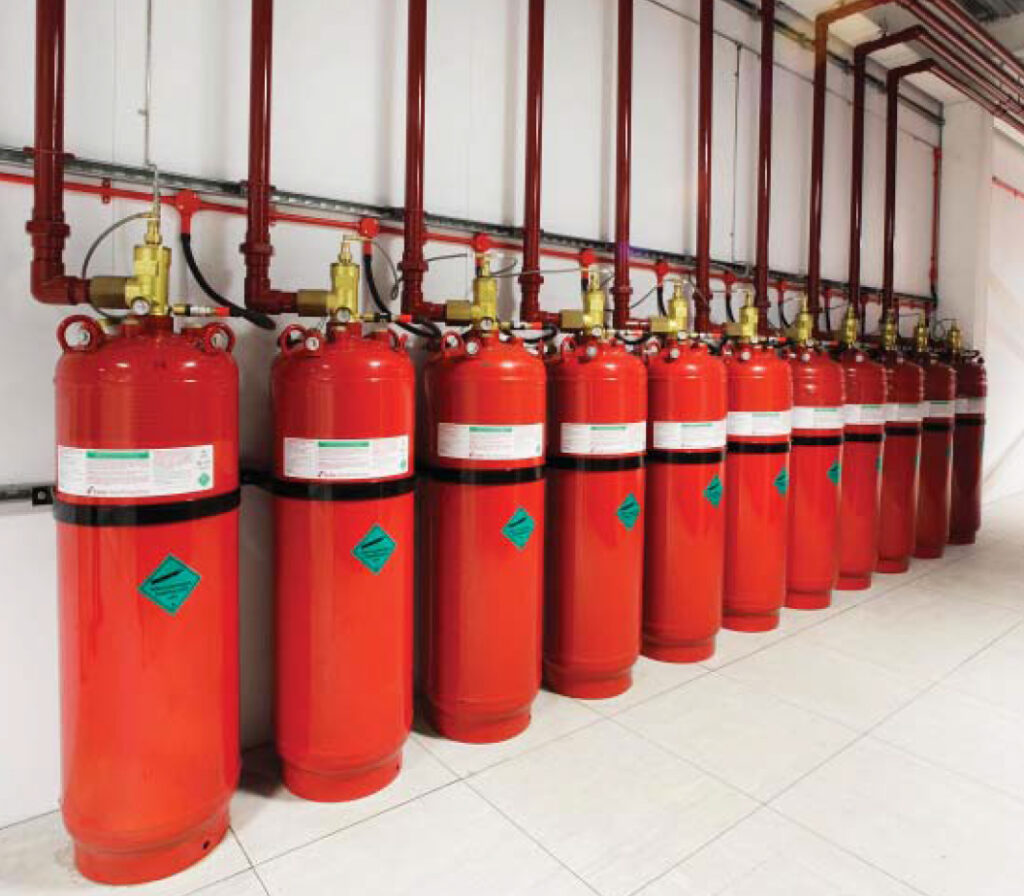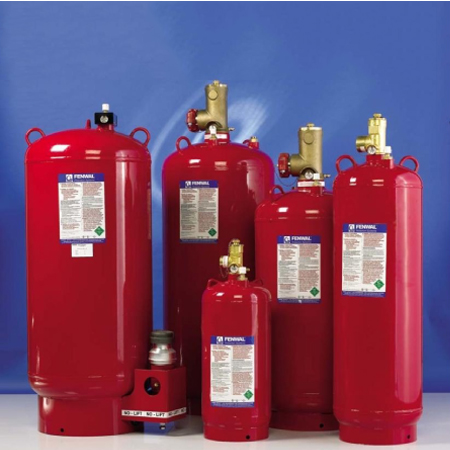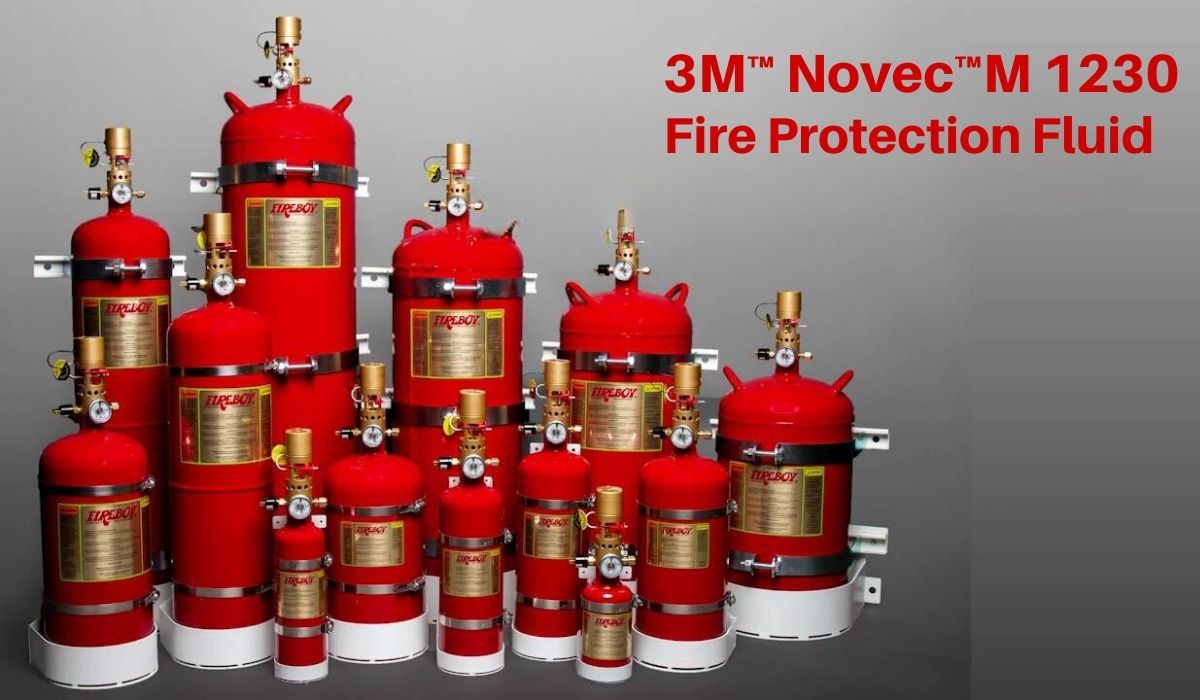Fire protection fluid is a specialized liquid used to suppress fires. It is designed to minimize damage and ensure safety.
Fire protection fluids are essential in safeguarding lives and property from fire hazards. These fluids are engineered to quickly extinguish fires, reducing their risk of spreading. They are used in various environments, including industrial settings, data centers, and commercial buildings.
Modern fire protection fluids are non-toxic and environmentally friendly, making them safe around people and sensitive equipment. They offer a reliable solution for fire suppression without causing harm. Implementing fire protection fluids can significantly enhance the safety measures of any establishment, ensuring rapid response during emergencies. Choosing the right fire protection fluid is crucial for effective fire management and safety compliance.
Introduction To Fire Protection Fluid
Fire protection fluid is a crucial part of fire safety measures. It helps prevent fires and protect valuable assets. This blog post will explore the basics of fire protection fluid.
What Is Fire Protection Fluid?
Fire protection fluid is a specialized liquid. It is designed to suppress fires quickly. This fluid is non-conductive and non-corrosive. It makes it safe for use around electronic equipment. Fire protection fluids are also environmentally friendly. They have low toxicity levels and are safe for humans and animals.
Importance In Fire Safety
Fire protection fluid plays a vital role in fire safety. It can extinguish fires in seconds. This rapid response minimizes damage and saves lives. Fire protection fluids are used in various settings:
- Data centers
- Healthcare facilities
- Industrial plants
- Commercial buildings
These fluids are effective against different types of fires. They are suitable for Class A, B, and C fires. This versatility makes them a popular choice for many applications. By using fire protection fluid, businesses can ensure safety and compliance.
| Setting | Benefits |
|---|---|
| Data Centers | Protects sensitive equipment |
| Healthcare Facilities | Ensures patient safety |
| Industrial Plants | Prevents costly downtime |
| Commercial Buildings | Safeguards property and occupants |
In summary, fire protection fluid is essential for fire safety. It offers quick and effective fire suppression. This ensures minimal damage and maximum protection.

Types Of Fire Protection Fluids
Fire protection fluids are essential for ensuring safety in various settings. These fluids help control and extinguish fires. They come in different types, each suited for specific situations. Below, we will explore the two main categories: Water-Based Solutions and Chemical Agents.
Water-based Solutions
Water-based solutions are the most common fire protection fluids. They are effective against many types of fires. These solutions include plain water, water mist, and water-based foams.
- Plain Water: This is the simplest form. It cools the fire and prevents its spread.
- Water Mist: This uses fine droplets. These droplets absorb heat quickly, reducing the fire’s temperature.
- Water-Based Foams: These are used for fires involving flammable liquids. They form a blanket over the liquid, cutting off the oxygen supply.
| Type | Best For | Advantages |
|---|---|---|
| Plain Water | Class A Fires | Abundant and inexpensive |
| Water Mist | Class A and B Fires | Efficient heat absorption |
| Water-Based Foams | Class B Fires | Effective on flammable liquids |
Chemical Agents
Chemical agents are specialized fluids. They are used for fires where water is not suitable. These agents include dry chemicals, clean agents, and wet chemicals.
- Dry Chemicals: These are powders. They interrupt the chemical reactions in the fire.
- Clean Agents: These are gases. They do not leave a residue, making them ideal for sensitive equipment.
- Wet Chemicals: These are liquids. They cool and form a barrier, especially effective for kitchen fires.
- Dry Chemicals: Best for electrical and flammable gas fires.
- Clean Agents: Ideal for data centers and museums.
- Wet Chemicals: Perfect for commercial kitchens.
Mechanism Of Action
The fire protection fluid is a vital component in fire safety systems. Understanding its mechanism of action helps us appreciate its effectiveness. This section delves into how it extinguishes fire and the role of heat absorption and cooling.
How It Extinguishes Fire
Fire protection fluid works by disrupting the fire triangle. The fire triangle consists of oxygen, heat, and fuel. Removing any of these components can extinguish a fire.
This fluid interrupts the chemical reaction within the fire. It forms a barrier between the fuel and the oxygen. Thus, it prevents the fire from spreading.
Here’s a quick breakdown of the process:
- Fluid disperses over the fire.
- It creates a thin layer on the fuel.
- This layer blocks oxygen from reaching the fuel.
- The fire is starved of oxygen and dies out.
Heat Absorption And Cooling
The fire protection fluid also absorbs heat from the fire. This absorption reduces the temperature of the burning material. Lower temperatures help in stopping the fire.
The cooling effect is crucial for preventing re-ignition. Once the heat is absorbed, the risk of the fire restarting is minimized.
Let’s look at some of the heat absorption properties:
| Property | Effect |
|---|---|
| High Specific Heat | Absorbs more heat |
| Thermal Stability | Maintains effectiveness under high temperatures |
These properties ensure the fluid can handle intense fire conditions. It absorbs heat rapidly, preventing the fire from gaining strength.
In summary, the fire protection fluid extinguishes fires by blocking oxygen and absorbing heat. This dual action makes it an effective solution for fire suppression.

Advantages Over Traditional Methods
Fire protection fluid offers many benefits compared to traditional methods. These modern solutions are designed to enhance safety and efficiency. They are also better for the environment.
Efficiency And Speed
Traditional fire suppression systems often use water or foam. These methods can be slow and cause damage. Fire protection fluid works quickly to put out fires.
Fire protection fluid reacts faster than water or foam. It can reach and extinguish flames in seconds. This quick action helps to minimize damage.
Here is a comparison:
| Method | Response Time | Damage Potential |
|---|---|---|
| Water | Minutes | High |
| Foam | Minutes | Moderate |
| Fire Protection Fluid | Seconds | Low |
Environmental Impact
Traditional fire suppression methods can harm the environment. Water can cause flooding. Foam can leave toxic residues.
Fire protection fluids are designed to be eco-friendly. They evaporate quickly and leave no harmful residues. This means less cleanup and environmental damage.
Here are some benefits:
- Non-toxic
- Biodegradable
- Low global warming potential
Using fire protection fluid helps protect the environment. It also ensures a safer and cleaner solution.
Application Areas
Fire protection fluid is essential for various environments. Understanding its application areas is crucial for effective fire safety. Below, we explore the primary application areas.
Industrial Use
Industries face high risks of fire incidents. Fire protection fluid plays a vital role in safeguarding these areas. Key industrial application areas include:
- Manufacturing Plants: Protects machinery and reduces downtime.
- Warehouses: Safeguards stored goods and inventory.
- Data Centers: Ensures the safety of critical data infrastructure.
- Oil & Gas Facilities: Minimizes fire risks in flammable environments.
- Chemical Plants: Protects against hazardous material fires.
Residential And Commercial Spaces
Fire protection fluid is equally important in homes and businesses. It ensures the safety of occupants and property. Common application areas include:
- Homes: Protects family and belongings from fire damage.
- Apartment Buildings: Ensures the safety of multiple households.
- Offices: Safeguards employees and business assets.
- Shopping Malls: Protects shoppers and retailers from fire hazards.
- Hospitals: Ensures the safety of patients and medical equipment.
- Schools: Protects students and educational resources.
| Area | Key Benefits |
|---|---|
| Manufacturing Plants | Protects machinery, reduces downtime |
| Homes | Protects family and belongings |
| Data Centers | Ensures safety of data infrastructure |
| Shopping Malls | Protects shoppers and retailers |

Credit: www.3m.com
Safety And Handling
Fire Protection Fluid is essential for fire safety. But it needs careful handling. Following safety guidelines helps prevent accidents and ensures proper use.
Storage Guidelines
Store Fire Protection Fluid in a cool, dry place. Avoid direct sunlight. Use a well-ventilated area to avoid fumes. Keep it away from incompatible materials such as acids and bases.
| Storage Condition | Requirement |
|---|---|
| Temperature | Keep below 25°C (77°F) |
| Humidity | Low, not exceeding 50% |
| Ventilation | Good air circulation |
Handling Precautions
Always use personal protective equipment (PPE). This includes gloves, goggles, and masks.
- Wear gloves to protect your hands.
- Use goggles to shield your eyes from splashes.
- A mask helps avoid inhaling fumes.
Follow these steps for safe handling:
- Read the safety data sheet (SDS) before use.
- Use in a well-ventilated area.
- Keep away from open flames and heat sources.
- Dispose of waste fluids properly.
Ensure emergency equipment like eyewash stations and showers are nearby. In case of a spill, clean it immediately using absorbent materials. Always label containers clearly. This avoids confusion and ensures safety.
Innovations In Fire Protection Fluids
Fire protection fluids have evolved significantly in recent years. These innovations provide better safety and efficiency. Advanced fluids can extinguish fires more quickly and safely. Let’s explore the latest advancements and future trends.
Recent Technological Advances
Recent technological advances in fire protection fluids are impressive. These fluids now use environmentally friendly chemicals. They are safer for people and the planet.
- Non-toxic formulas: Modern fluids are non-toxic and safe for humans.
- Faster response: They extinguish fires much faster than older fluids.
- Reduced damage: New formulas cause less damage to property.
These advances make fire protection more reliable. Businesses and homes are safer with these new fluids.
Future Trends
The future of fire protection fluids looks promising. Here are some trends to watch:
- Smart fluids: These will adapt to different fire types automatically.
- Eco-friendly options: New fluids will have minimal environmental impact.
- Enhanced efficiency: Fluids will become even more effective at putting out fires.
Research and development are ongoing. Expect continuous improvements in fire safety technology.
| Feature | Old Fluids | New Fluids |
|---|---|---|
| Toxicity | High | Low |
| Response Time | Slow | Fast |
| Environmental Impact | High | Low |
| Property Damage | High | Low |
Stay updated with these trends to ensure the best fire protection. New innovations keep us safer every day.

Credit: www.suppression.com
Case Studies And Real-world Examples
Fire protection fluid plays a crucial role in safeguarding properties and lives. Here are some real-world examples and case studies showcasing its effectiveness. These stories highlight the importance of choosing the right fire protection solutions.
Success Stories
Many businesses have benefited from using fire protection fluid. One notable example is a data center in Silicon Valley. A fire broke out in one of their server rooms. The fire protection fluid quickly extinguished the flames, saving millions in equipment and data.
Another success story involves a historic library in Europe. The library housed rare and irreplaceable books. A small electrical fire started in the archives. Thanks to the fire protection fluid, the fire was put out instantly. The priceless collection remained unharmed.
Lessons Learned
From these real-world examples, several lessons can be drawn. First, quick response is critical in fire emergencies. Fire protection fluid provides that rapid reaction. Second, protecting valuable assets like data and historical items is essential. Fire protection fluid proves effective in such scenarios.
Businesses should also invest in regular maintenance of their fire protection systems. This ensures the fluid remains effective when needed. Another lesson is the importance of staff training. Employees must know how to respond during a fire. This reduces panic and ensures a swift reaction.
Finally, businesses must choose the right type of fire protection fluid. Different environments require different solutions. Consulting with fire safety experts helps in making the right choice.
| Business Type | Incident | Outcome |
|---|---|---|
| Data Center | Server Room Fire | Fire Extinguished, Data Saved |
| Historic Library | Electrical Fire | Fire Extinguished, Books Saved |
In summary, real-world examples show the effectiveness of fire protection fluid. Quick response, asset protection, and regular maintenance are key takeaways. Choose the right fluid and ensure staff know how to respond. This can make all the difference during a fire emergency.
Frequently Asked Questions
What Liquid Is In A Fire Suppression System?
A fire suppression system typically uses water, foam, or chemical agents like FM-200 or CO2 to extinguish fires quickly.
What Is 1230 Fire Protection Fluid?
1230 fire protection fluid is a clean, non-conductive fire suppressant. It quickly extinguishes fires without water damage. Suitable for data centers, museums, and sensitive environments. Safe for people and equipment, it leaves no residue.
What Is The Difference Between Fk-5-1-12 And Fm-200?
FK-5-1-12 and FM-200 are both clean agents used for fire suppression. FK-5-1-12 is environmentally friendly with zero ozone depletion potential, while FM-200 has a higher global warming potential. FK-5-1-12 is often preferred for green certifications, whereas FM-200 is widely used for its effectiveness and established track record.
Is Novec 1230 Harmful To Humans?
Novec 1230 is generally safe for humans when used properly. It has low toxicity and does not deplete oxygen.
Conclusion
Choosing the right fire protection fluid is crucial for safety. It offers efficient fire suppression and minimal environmental impact. Invest in quality fire protection fluids to safeguard assets and lives. Ensure regular maintenance for optimal performance. Stay safe and protected with the best solutions available.

I’m Abdus Sobur, a highly skilled and professional Fire Safety Officer with a passion for safeguarding lives and property. Over the course of my career, I’ve conducted numerous successful fire safety audits, earning a reputation for excellence in ensuring public safety.
In addition to my role as a Fire Safety Officer, I’m also dedicated to raising awareness about the importance of fire safety. Through my blog, I share insights into the functions of different fire safety equipment, aiming to empower individuals with the knowledge they need to protect themselves and their communities.
I’m driven by a deep commitment to promoting fire safety awareness and preventing fire-related incidents.

